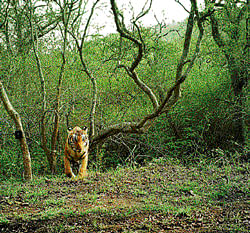
The Forest department is all set to implement the camera-trapping method of keeping a track of tigers in the Yelandur range of the Biligiri Ranganathaswamy Temple (BRT) Tiger Reserve.
The method is already in place, with 30 cameras keeping an eye on the movement of tigers, other animals and poachers in the Kollegal range of the tiger reserve. There are a total of six ranges in the BRT tiger reserve. The camera-trapping method is seen as a fool-proof mechanism in the tiger census.
The measure is in keeping with the initiative of the National Tiger Conservation Authority that has been working to provide unique ID numbers for tigers along the lines of Aadhaar numbers for citizens in the country.
The automatic cameras, installed on either sides of tiger corridors, capture images of the big cats during their movement within their individual boundaries in the forest. The stripes on the bodies are used to identify each individual big cat. The first-of-its-kind initiative by the Forest department is said to be a giant step in tiger conservation efforts.
Through this system, the Forest department staff (right from the lower rung to the level of the conservator of forests and the director of Project Tiger), who know the nook and corner of the reserve forest, hope to streamline the conservation efforts and count the big cat numbers accurately. They can also crack down on the poachers easily with the help of the camera images.
When tigers migrate to another location, images captured through this method will help ascertain their original reserve. The date and time when the images are captured are also recorded. It method also helps to know in which reserve a tiger has been killed whenever the authorities recover pelts from poachers. The images can also be produced as evidence in the court while prosecuting the poachers.
S S Lingaraju, Conservator of Forests of the BRT Tiger Reserve and Director, told Deccan Herald that camera-trapping would now be a continuous process and would be extended to all ranges in the reserve.